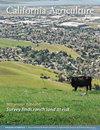Using Ecological Site Descriptions to make ranch-level decisions about where to manage for soil organic carbon
IF 1.1
4区 农林科学
Q2 AGRICULTURE, MULTIDISCIPLINARY
引用次数: 1
Abstract
Maintaining and enhancing soil organic carbon storage can mitigate climate change while promoting forage growth. California has adopted incentive programs to promote rangeland practices that build soil organic carbon. However, there is no standard framework for assessing the baseline level of soil organic carbon at the ranch scale. Here, we use the Ecological Site Description — a land-type classification system — to help ranch managers set priorities about where to implement practices to increase soil organic carbon. We measured baseline carbon stocks at 0 to 15 and 15 to 30 centimeters' depth across three ecological sites and two vegetation states (shrubland and grassland) at Tejon Ranch, California. We discovered increased levels of soil carbon at ecological sites in higher elevations, and more soil carbon in shrublands as compared to grasslands. Slope, elevation, and soil texture, as well as plant litter and shrub cover, were significant predictors of soil carbon. The Ecological Site Description framework can serve as an important tool to help range managers keep carbon in the soil and out of the atmosphere.利用生态站点描述对牧场层面的土壤有机碳管理进行决策
维持和提高土壤有机碳储量可以在减缓气候变化的同时促进牧草生长。加州采取了激励计划,以促进牧场的做法,以增加土壤有机碳。然而,目前还没有一个标准的框架来评估牧场尺度下土壤有机碳的基线水平。在这里,我们使用生态站点描述(一种土地类型分类系统)来帮助牧场管理者确定在哪里实施增加土壤有机碳的措施的优先顺序。我们在加利福尼亚州Tejon牧场的三个生态点和两个植被状态(灌木和草地)测量了0至15厘米和15至30厘米深度的基线碳储量。我们发现,在海拔较高的生态地点,土壤碳含量增加,与草原相比,灌木地的土壤碳含量更高。坡度、海拔、土壤质地以及植物凋落物和灌木覆盖是土壤碳的重要预测因子。生态站点描述框架可以作为一个重要的工具,帮助牧场管理者保持土壤中的碳和大气中的碳。
本文章由计算机程序翻译,如有差异,请以英文原文为准。
求助全文
约1分钟内获得全文
求助全文
来源期刊

California Agriculture
农林科学-农业综合
CiteScore
2.40
自引率
7.70%
发文量
17
审稿时长
>12 weeks
期刊介绍:
Information not localized
 求助内容:
求助内容: 应助结果提醒方式:
应助结果提醒方式:


